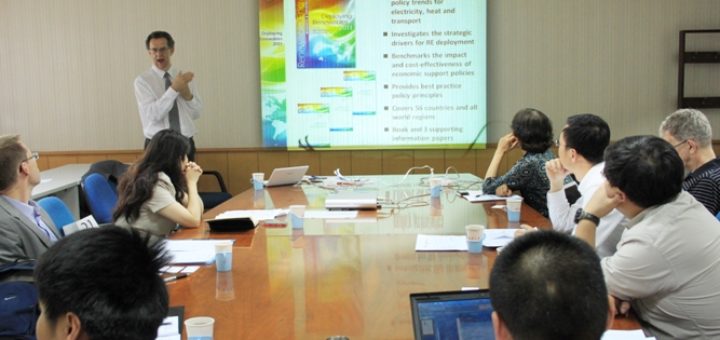Innovation in mitigation technologies is seen as a critical contributor to achieving the ambitious GHG reduction goals of countries outlined in the Paris Agreement. The CARISMA project has analysed collaboration initiatives from governments, industries, and regions, each with different characteristics, to identify criteria for effective collaborations between the EU and emerging countries. The main finding of the analysis is that there is no unique pattern that could correspond to every good practice of collaborations.
Innovation in mitigation technologies is seen as a key contributor to achieving the ambitious greenhouse gas reduction goals of countries outlined in the Paris Agreement. Research collaboration on mitigation technology and innovation between developed and developing countries offers the opportunity for trust building, knowledge sharing and allows all parties to influence the decision-making process of technology development. The CARISMA project has analysed collaboration initiatives from governments, industries and regions, each with different characteristics, in order to identify criteria for effective collaborations between the European Union and emerging countries.
In May 2017, the EU-funded CARISMA project has published a Working Document and two Policy Briefs on the topic of international collaboration on research and innovation for climate change mitigation. The Working Document (CARISMA 5th Working Document: Internationall R&D Collaboration on Mitigation, pdf) gives an extensive overview of more than 30 collaboration initiatives as well as six in-depth case studies. The two Policy Briefs focus on the following topics:
- How should international institutions promote research and innovation collaboration for climate change mitigation?, pdf (by Sören Lindner and Heleen de Coninck, Radboud University)
- Government-led international research and innovation collaboration in climate mitigation: Practical guidance for policymakers, pdf (by Katja Tuokko, Monica Alessi, and Arno Behrens)
Background
The aim of the Working Document and Policy Briefs on research and innovation (R&I) collaboration initiatives in international climate change mitigation is to provide an illustrative mapping of R&I collaboration between industries, between governments, and initiated by regional organizations, involving EU Member States and emerging economies.
Readers will get a better understanding on the impact of R&I collaboration in the mitigation technology ecosystem and its contribution to mitigating global climate change as well as potential barriers hindering a successful collaboration. Research and innovation initiatives have the potential to advance climate technology transfer across borders. This is the case regarding the uptake of climate technologies in developing countries, where the deployment of climate technologies can facilitate meeting countries’ respective NDCs (National Determined Contributions) under the Paris Agreement (Ockwell et al., 2015). Collaborations between developed and developing countries, in particular technology transfer and capacity building, can function as a strong driver for decarbonisation (Dechezleprêtre, 2013). One indication of the growing importance of collaborations in climate change mitigation is the growing number of international collaborations on R&D programmes, which according to the OECD has doubled between 1996 and 2005. While mappings of efforts and initiatives are carried out under the UNFCCC and in previous research, a comprehensive overview of these initiatives is currently lacking and is needed to provide policy makers with key information to focus efforts on priority areas, avoid unnecessary duplication, and optimise resource utilisation.
The mapping will contribute to our understanding of how technology cooperation takes place at the moment, which technologies and types of cooperation dominate, and what are drivers that impact the depth and form of technology cooperation. It is furthermore meant to increase awareness on bilateral initiatives and to stress the increasing importance of the private sector involvement in collaborations. While EU programmes run by the European Commission are well-documented and relatively easily found, national bilateral initiatives by Member States are not widely known and difficult to identify. Having an insight into bilateral agreements could help to develop a better understanding of the overall European involvement in international R&I collaboration. This in turn will allow policy makers to increase the coordination and coherence of support actions and reinforce the policy diffusion and market creation for climate mitigation and adaptation technologies, improving synergies and avoiding unnecessary duplication.
Key findings
The main finding of the analysis is that there is no unique pattern which could correspond to every good practice of collaborations. Depending on the scale and size of the project, the actors (regional, governmental or industrial) involved, the sector, and the type of activity (innovation, capacity building, knowledge sharing), optimal structures may vary.
We found that effective collaboration requires a well-defined strategy and offers well-identified benefits for stakeholders. An efficient monitoring system should also be implemented to enable incremental improvements. Public decision makers should implement policies which encourage collaborations. A combination of financial, fiscal incentives, or labelling could be examples of such policy matrix that may encourage collaborations. Industry members should understand that research collaborations could be opportunities both for growth and to mitigate their impact on climate.
Downloads
The PDF files are available to download from the CARISMA website:
- CARISMA 5th Working Document: Internationall R&D Collaboration on Mitigation, pdf
- How should international institutions promote research and innovation collaboration for climate change mitigation?, pdf (by Sören Lindner and Heleen de Coninck, Radboud University)
- Government-led international research and innovation collaboration in climate mitigation: Practical guidance for policymakers, pdf (by Katja Tuokko, Monica Alessi, and Arno Behrens

This article is an output of the EU-funded CARISMAproject.
CARISMA
CARISMA project
Project details
- Project title: “Coordination and Assessment of Research and Innovation in Support of climate Mitigation Actions” (CARISMA)
- Funding scheme: European Union Horizon 2020 Programme (EU H2020, grant agreement no. 642242)
- Duration: 3.5 years (1 February 2015 – 31 July 2018)
- Project coordinator: Radboud University, Nijmegen, the Netherlands
- Project website: www.carisma-project.eu


